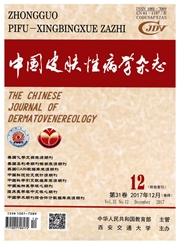

 中文摘要:
中文摘要:
目的了解冬季光敏性面部皮炎的临床特征及发病诱因。方法对本院2015年冬季收治的137例紫外线敏感试验呈阳性的面部皮炎患者进行问卷调查,包括基本信息、皮损临床特征和发病因素并进行随访。结果137例患者中,91.24%的光敏试验阳性的患者为女性,高发人群为销售/服务业人员、学生及文秘等,平均使用手机时间为每天4h。这些患者皮损与春夏季光敏性皮炎不同,主要表现为分布于眼睑、面颊以及鼻周、口周、眼周的红斑和斑丘疹,范围局限,伴轻至中度瘙痒。避免长时间使用手机后皮损消退的患者有97例(占70.80%)。结论冬季面部皮炎需考虑光敏感原因,持续智能手机暴露可能是冬季光敏感的重要诱因。
 英文摘要:
英文摘要:
Objective To understand clinical characteristics and incentives of winter facial photodermatoses . Methods A questionnaire on 137 facial dermatitis patients who were positive for phototesting in winter in our hospital is taken, including basic information, clinical features and pathogenic related factors and then we followed patients up. Results 91.24% of 137 patients who were positive for phototesting were female. Occupations at high risk were salesmen/service personnel students and secretaries who spent 4 h/d on average on smart phones. Compared to summer or spring photodermatoses, winter facial photodermatoses was characterized by red patches and maculopapules with slight to moderate itching , mainly on the eyelids, cheeks and the skin around eyes, mouths or noses. Ninety-seven cases of( 70. 80% )patients were cured by avoiding persisitant smart phones exposure. Conclusions Photosensitivity is also a significant reason for winter photodermatoses that need to be taken into account. Persistent smart phones exposure maybe a major cause of winter facial photodermatoses.
 同期刊论文项目
同期刊论文项目
 同项目期刊论文
同项目期刊论文
 期刊信息
期刊信息
